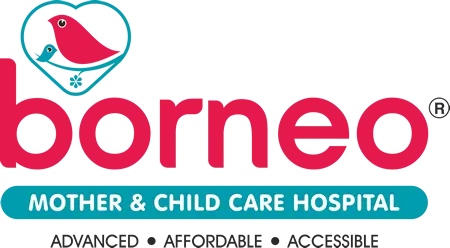Congratulations, new mother! You have just accomplished the incredible feat of bringing a new life into the world. In the beautiful, hazy days that follow delivery, your focus naturally and completely shifts to your precious newborn – their every feed, nappy change, and cuddle. However, it’s vitally important to remember that this period, the “fourth trimester,” is also a crucial time for your own healing. Your body has been through a marathon, and it deserves time, care, and attention to recover its strength.
My name is Dr. Vrushali Pillai, and as a Senior Consultant Obstetrician & Gynaecologist at Borneo Hospital, Thane – part of the Borneo Hospitals group serving families across Thane, Nashik, Chhatrapati Sambhaji Nagar, and Raipur City – I am passionate about guiding women through their postpartum journey. A healthy, well-supported mother is the foundation of a healthy, thriving family.
This article aims to be your realistic guide to Post-Birth Recovery, specifically after a low-intervention vaginal delivery. We will explore what to expect in the hours, days, and weeks that follow, and offer practical self-care tips to help you heal comfortably and confidently. Remember, even the most ‘natural’ birth requires a significant recovery period, and patience with your body is key.
The “Golden Hours”: The Immediate Postpartum Period (First 24 Hours)
Right after you deliver your baby, while you are enjoying those precious first moments of skin-to-skin contact and attempting the first feed, your body is already beginning its amazing recovery process.
1. Uterine Contractions (Afterpains):
Your uterus has to shrink from the size of a watermelon back down to the size of a pear! It does this through ongoing contractions. These ‘afterpains’ can feel like period cramps and are often more noticeable during breastfeeding, as the hormone oxytocin, which stimulates milk let-down, also causes the uterus to contract. While uncomfortable, these are very good and necessary signs of healing.
2. Postpartum Bleeding (Lochia):
You will have a vaginal discharge called lochia, which consists of blood and tissue from the uterine lining. For the first few days, expect it to be like a very heavy period – bright red and possibly containing some small clots. Our nursing team at Borneo Hospital will monitor your bleeding closely immediately after birth to ensure it is within a normal, safe range.
3. Perineal Soreness:
It is completely normal to feel quite sore, swollen, and tender in the perineal area (the area between your vagina and anus). If you had a natural tear or an episiotomy that required stitches, this area will be particularly sensitive.
4. Exhaustion & Elation
You will likely feel a profound sense of exhaustion, mixed with the incredible high of meeting your baby. This emotional rollercoaster is a normal part of the immediate Post-Birth Recovery phase.

The First Week: Your Healing Journey Begins at Home
Those first few days at home are about three things: feeding your baby, bonding, and your own rest and gentle self-care.
1. Perineal Healing & Care (A Key Focus):
Caring for your perineum properly will improve your comfort and help prevent infection.
- What to Expect: Soreness and swelling are normal and will gradually get better over the first week or two. If you have stitches, they are usually the dissolvable type and will not need to be removed.
- Essential Self-Care Tips:
- Peri-Bottle: This is your best friend! Use a peri-bottle or a small jug filled with warm water to gently rinse the perineal area from front to back each time you use the toilet. This is much more soothing than wiping with toilet paper. Gently pat the area dry with a clean, soft cloth or tissue.
- Sitz Baths: Sitting in a shallow tub of clean, warm water for 10-15 minutes, two or three times a day, can provide immense relief from soreness and promote healing. There’s no need to add any antiseptic liquids unless specifically advised by your doctor.
- Ice Packs: In the first 24-48 hours home, using a wrapped ice pack or a chilled maternity pad against the perineum for 10-15 minutes at a time can significantly reduce swelling and provide pain relief.
- Pain Relief Medication: It is important to stay comfortable. Take your doctor-approved pain relief medication, such as paracetamol or ibuprofen, regularly as needed. Staying on top of pain management helps you rest better.
- Comfortable Sitting: Sit on a soft cushion or a ‘donut’ ring if you find it helps. When resting, try to lie on your side to take pressure off the area.
2. Managing Postpartum Bleeding (Lochia):
- Expect your bleeding to be like a heavy period for the first few days. You will need to use heavy-duty maternity sanitary pads and change them frequently (every 3-4 hours) to maintain good hygiene and prevent infection. You should avoid using tampons for at least six weeks after delivery.
3. Bowel & Bladder Function:
- It is common to feel a stinging sensation when you pass urine initially. Pouring warm water over the area with your peri-bottle while you urinate can help dilute the urine and reduce the sting.
- The thought of your first bowel movement can be quite frightening, especially with stitches. To help prevent constipation and make it easier, drink plenty of water, eat high-fibre foods (like dals, whole grains, fruits, and vegetables), and avoid straining. Talk to your doctor about using a safe, gentle stool softener if you are concerned.
Weeks 2 to 6: Continued Post-Birth Recovery & Adjustment
Your body continues to heal and adapt during this crucial period of Post-Birth Recovery.
- Continued Perineal Healing: By the second week, the initial intense soreness should be significantly better. You will likely find walking and sitting much more comfortable. Any stitches will be dissolving.
- Lochia Tapers Off: The bleeding will continue to lessen and change in colour. It will go from red, to pink, then brown, and finally to a yellowish or whitish discharge. This process can last for up to six weeks.
- Breast Care: If you are breastfeeding, your milk supply usually regulates during this time. Manage any ongoing nipple soreness by focusing on a good latch and seek help from our lactation consultants if needed. If you are not breastfeeding, wear a firm, supportive bra and avoid stimulating your breasts to help your milk supply decrease comfortably.
- Fatigue & Sleep Deprivation: The tiredness is profound and real. The mantra “sleep when the baby sleeps” is not just a cliché; it is essential medical advice for your recovery. Let the housework wait and prioritise your rest.
- Abdominal & Core Weakness: Your abdominal muscles, which stretched significantly during pregnancy, will feel weak and soft. It takes time for them to regain their tone. You can start with very gentle core exercises, like deep belly breathing (diaphragmatic breathing), to begin reconnecting with these muscles.
- Postpartum Hair Loss (Telogen Effluvium): Do not be alarmed if you notice increased hair shedding, often starting around the three-month mark. This is a normal hormonal response and is temporary. Your hair growth cycle will return to normal over the next several months.
- Emotional Well-being: The ‘baby blues’ – feeling emotional, weepy, and a bit overwhelmed – are very common in the first week or two. However, if these feelings are severe, or if feelings of sadness, anxiety, and hopelessness persist beyond two weeks, it’s important to talk to your doctor, as this could be a sign of Postpartum Depression.

A Brief Contrast: How Recovery Differs After Interventions
For context, it is helpful to understand how your Post-Birth Recovery may differ from other birth experiences. Recovery from a Caesarean section is different as it is a major abdominal surgery. It typically involves a longer hospital stay, more significant initial pain management, and a longer period (at least six weeks) of avoiding heavy lifting and strenuous activity to allow the abdominal incision to heal properly. If your vaginal birth required assistance from forceps or a vacuum, you might experience more significant perineal bruising, swelling, or tearing, which might slightly extend your initial recovery time compared to a spontaneous, unassisted birth.
Returning to Activity: A Gradual and Gentle Approach
- Rest is Your Main Priority: In the early weeks, rest is the most important activity you can do. Your bodys energy is focused on healing.
- Gentle Walking: Once you feel comfortable and your doctor gives you the okay, starting with short, gentle walks is a great way to begin moving your body again.
- Pelvic Floor Exercises (Kegels): These are vital for all new mothers. You can usually start these simple exercises very gently as soon as you feel comfortable after delivery. Squeeze the muscles you would use to stop urination, hold for a few seconds, and release. Repeat this regularly throughout the day. These are crucial for bladder control and supporting your pelvic organs long-term.
- The 6-Week Check-Up: This visit with your doctor at Borneo Hospital is your key milestone. It’s when you will typically get medical clearance to resume more strenuous activities like going to the gym, running, or other sports. Do not rush back into high-impact exercise before this important check-up.
- Listen to Your Body: This is the golden rule for your entire Post-Birth Recovery. Stop any activity that causes pain, discomfort, or an increase in your vaginal bleeding. Everyone’s recovery timeline is unique.
Red Flags: When to Call Your Doctor at Borneo Hospital
While some discomfort is a normal part of healing, certain symptoms require immediate medical attention. Please contact your doctor or seek urgent care at Borneo Hospital if you experience any of the following:
- Heavy Bleeding (Signs of Postpartum Haemorrhage): Soaking through more than one large maternity pad in an hour, passing very large blood clots (bigger than an egg), or if your bleeding suddenly becomes heavy and bright red again after it had started to lighten.
- Signs of Infection: A fever (100.4°F/38°C or higher) and chills; foul-smelling vaginal discharge (lochia); or increasing pain, redness, swelling, or pus from your perineal stitches.
- Severe Pain: Severe or worsening pain in your perineum, abdomen, or lower back that is not relieved by your usual pain medication.
- Leg Symptoms: Pain, swelling, redness, or warmth in one of your calves, which could be a sign of a deep vein thrombosis (DVT), a serious blood clot.
- Urinary Issues: A sudden inability to pass urine, or severe pain and burning when urinating (signs of a UTI).
- Severe Mental Health Symptoms: Signs of severe Postpartum Depression, including thoughts of harming yourself or your baby.
- Trust Your Instincts: If something just doesn’t feel right about your recovery, it is always best to call your doctor for advice.
Your Post-Birth Recovery after a natural delivery is a significant healing process that requires patience, respect for your body, and dedicated self-care. Your body has performed a miracle, and it now needs to be nurtured back to strength.
Focus on the key elements of recovery: diligent perineal care, prioritising rest above all else, nourishing yourself with healthy food and plenty of fluids, starting gentle movement only when you feel ready and have been cleared by your doctor, and being aware of your emotional well-being. Attending your 6-week postnatal check-up is a vital step in confirming your healthy recovery. Be kind to yourself during this “fourth trimester,” accept help from your loved ones, and know that the team at Borneo Hospital is here to support you.



